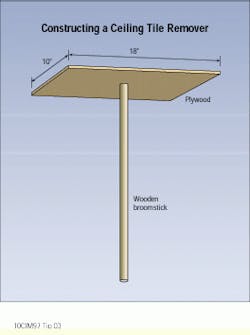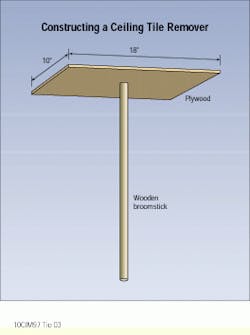Removing a tile from a drop ceiling
Dennis Mazaris, PerfectSite
Problem
After ceiling tiles have been installed, routing horizontal cables can lead to extra work for the installer because he or she has to climb a ladder several times to remove ceiling tiles to establish a cable pathway. Also, dust from ceiling tiles can fall during this procedure, and tiles can break.
Solution
Prefabricate a drop-ceiling tile remover from a piece of plywood and a wooden broom handle. This simple remover lets the installer remove tiles while standing on the floor, resulting in a quick, efficient installation with fewer trips up the ladder. Ultimately, the procedure also minimizes ceiling-tile dust.
Procedure
1) Cut a 1/4-inch-thick piece of plywood with the dimensions of 10 by 18 inches.
2) Attach a wooden broom handle to the plywood.
3) Extend the ceiling-tile remover to the tile and center it under the tile. Then lift the remover so that the ceiling tile slides onto it.
4) If resistance is felt when lifting the tile from the center, then move the tile remover under the tile`s edges where it meets the ceiling-tile support grid. Continue to lift the tile.
5) When lifting ceiling tiles, make sure you select tiles with an unobstructed area above them. These areas provide a clear pathway for your cables and supporting system.
You may want to apply bubble wrap to the plywood`s surface. This will protect the tile from damage caused by the plywood.
Attaching a wooden broomstick to a 10 x 18-inch piece of plywood makes a useful tool for removing ceiling tiles. The remover helps lift tile off its supporting grid, eliminating the need to climb a ladder each time you remove a tile.
Dennis Mazaris, registered communications distribution designer (rcdd), is the principal consultant for PerfectSite (Sterling, VA), a consulting firm specializing in premises cabling management and design.

